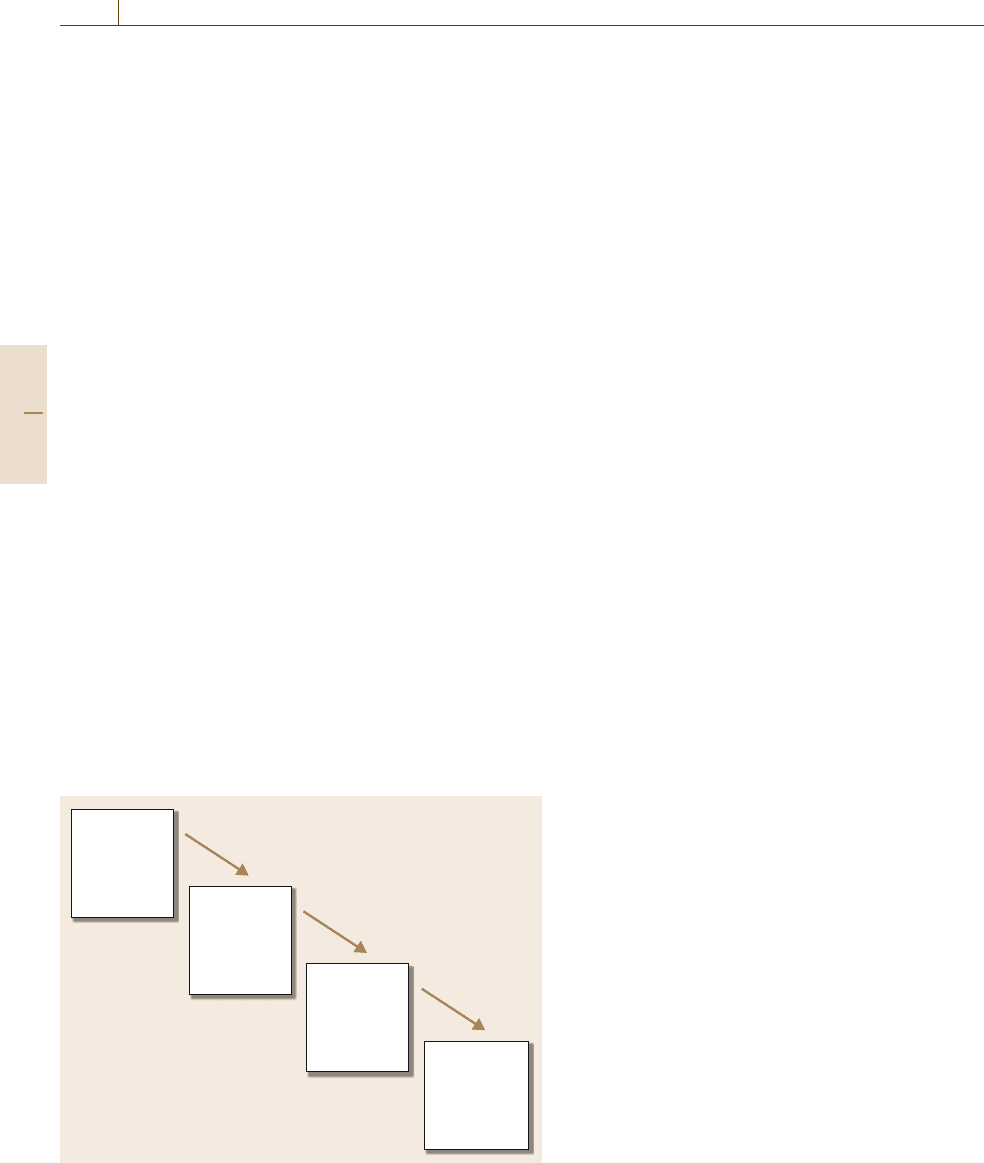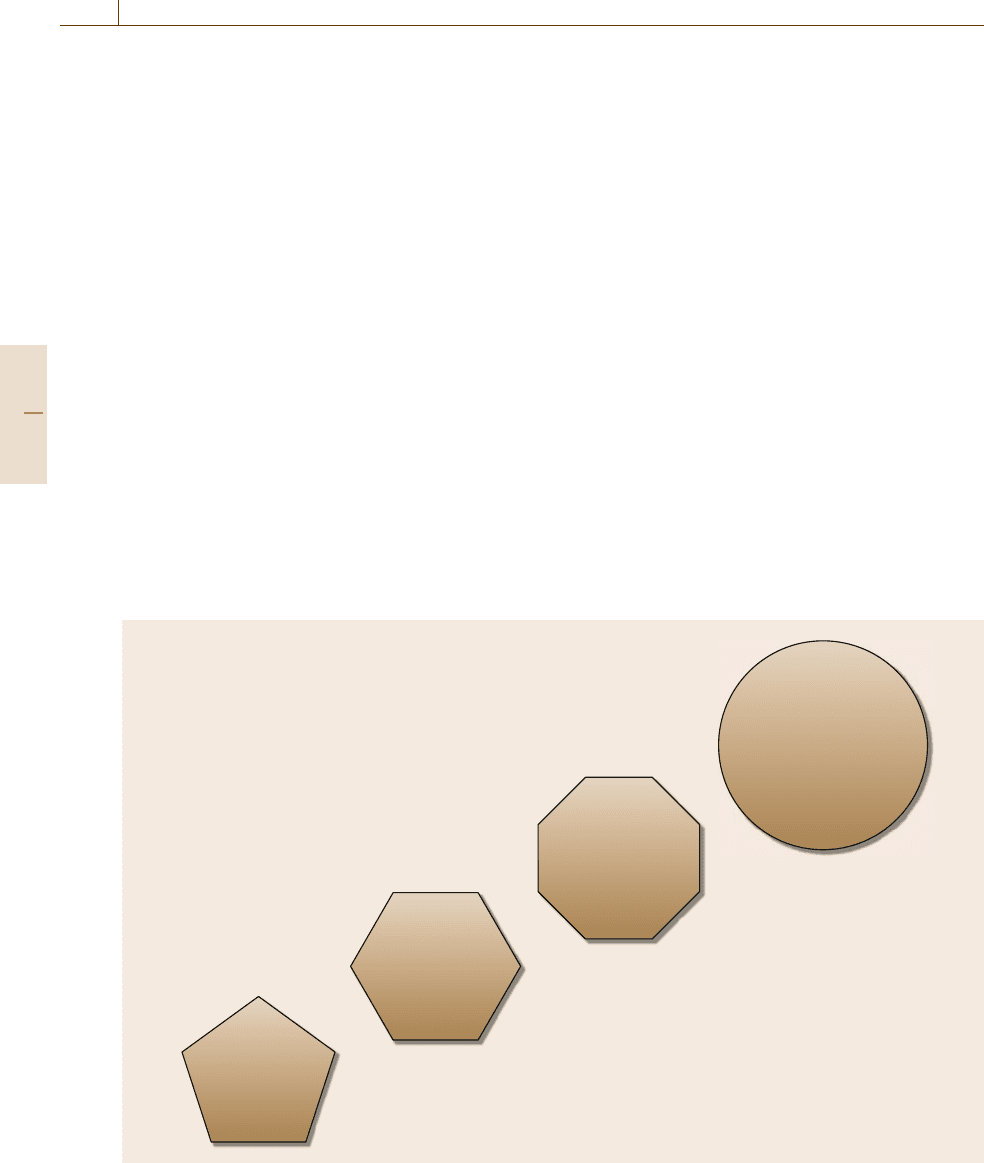Nof S.Y. Springer Handbook of Automation
Подождите немного. Документ загружается.


1265
Automating I
71. Automating Information and Technology Services
Parasuram Balasubramanian
While the information services industry dates
back to the 15th century AD, the information
technology services is as young as 60 years. Yet
the pace at which both have grown is phe-
nomenal, and this is tied to the evolution
of computer technology. Networking of com-
puters and people through the Internet has
moved into high gear. It has also given birth
to multiple business segments in the pro-
cess. Delivery of data and information, data
processing, business process outsourcing, an-
alytics, and printing and display solutions are
the five segments identified within the in-
formation services. Computer-aided software
engineering, independent software testing
and quality assurance, package and bespoke
software implementation and maintenance,
network and security management, and host-
ing and infrastructure management are covered
as segments within information technology
services. The automation path of each seg-
ment is reviewed in detail. An impact analysis
to identify the changing landscape is de-
scribed. Finally current trends are traced,
followed by predictions for future develop-
ments.
71.1 Preamble ............................................ 1265
71.1.1 Evolution of the Information
and Technology Services Industry .. 1266
71.1.2 The Opportunity for Automation.... 1266
71.2 Distinct Business Segments .................. 1267
71.3 Automation Path
in Each Business Segment .................... 1269
71.3.1 Delivery of Data and Information .. 1269
71.3.2 Data Processing........................... 1269
71.3.3 Business Process Outsourcing........ 1271
71.3.4 Analytics .................................... 1272
71.3.5 Printing and Display Solutions ...... 1273
71.4 Information Technology Services........... 1274
71.4.1 Computer-Aided
Software Engineering .................. 1274
71.4.2 Independent Software Testing
and Quality Assurance ................. 1275
71.4.3 Package and Bespoke Software
Implementation and Maintenance 1277
71.4.4 Network
and Security Management............ 1278
71.4.5 Hosting
and Infrastructure Management ... 1280
71.5 Impact Analysis ................................... 1281
71.6 Emerging Trends ................................. 1282
References ................................................. 1282
71.1 Preamble
The design specification for the electronic voting ma-
chines (EVMs) used in 2004 national elections in India
had to take account of the high level of illiteracy among
citizens, cater for more than 14 different languages,
tackle poor infrastructure in terms of road network and
power availability in rural polling stations, and accept
manual methods of voter authentication [71.1]. Nearly
1.3 million EVMs adhering to the above specification
were deployed in the election, in which 330 million cit-
izens voted. The election process went off without any
significant problem with respect to the EVMs. Mean-
while inEurope, near Paris, a high-technology company
has been engaged in using crash simulation software on
Intel personal computers (PCs) to model and test new-
generation vehicles to meet regulatory requirements
without building expensive prototypes [71.2]. Not to be
left behind in the innovation race, many firms in Europe
and the USA have been busy delivering portable car
navigation systems using the global positioning system
(GPS) to the mass market.
Part G 71

1266 Part G Infrastructure and Service Automation
These three cases represent the current state of the
art in automation in information and technology ser-
vices industries. The contexts are different and the level
of automation varies, yet all three are powerful exam-
ples of information technology making its impact on
mankind. The transformational power of this industry,
as it impacted on the USA from the colonial period to
current times, is traced by Chandler andCortada [71.3].
The progress achieved is significant and exponen-
tial over the past 60years, ever since computers entered
this arena. As a general-purpose machine, the computer
has invaded almost all aspects of human life. Comput-
erization has resulted in productivity gains that could
not have been dreamt of until the 20th century. It has
been a process of unceasing innovations, integration
of diverse devices, seamless merger of hardware and
software, and evolution of new market paradigms. It
has also given birth to an industry focused on provid-
ing information technology (IT) services to companies,
governments, universities, and the public at large. It is
worth studying this process to understand the growth of
this industry and where it is headed.
71.1.1 Evolution of the Information
and Technology Services Industry
Johann Gutenberg introduced the printing press in
1436 AD in Europe and is credited for opening the
doors to the Renaissance and the scientific revolu-
tion [71.4]. The information services industry was born
with the mass production of books (within the next
50years 8 million books were printed) and it facilitated
sharing of knowledge among scholars, particularly in
Europe [71.5, 6]. The mass media industry consisting
of newspapers, magazines, radio, television, and adver-
tising, however, had to wait until the 19th century (for
Marconi, Edison, and Walter Thompson to give birth
to). A brief view of its growth in the USA is con-
tained in [71.7]. The invention of the telegraph and
Morse code by Morse in 1835 and the telephone in
1870 by Graham Bell, and their rapid spread of us-
age, along with the above, ensured that the spoken word
joined the printed one to be shared across the world.
Emile Berliner, standing on the shoulders of Edison
and other eminent scientists, patented the gramophone,
thus paving way for the music industry. A comprehen-
sive view of each of these inventions and inventors is
available on the Internet [71.8].
However, a parallel development over the centuries,
in mathematics coupled with mechanical and electronic
devices, led the development of information technol-
ogy. Calculators (Pascal, 1642) gave way to the analytic
engine of Babbage (1832), and Hollerith’s tabulating
machine was used first in the 1890 US census. The mid-
dle of the 20th century saw the invention of computers
and the world has been spinning fast ever since. Along
with computers, the informationtechnology services in-
dustry was born in the 1950s and has grown in multiple
dimensions [71.9].
Computer architecture separated the data input from
its processing and output layers and exploited the dis-
tinction between data and logic. Advances in input
devices, storage devices, processors, and data presen-
tation layer during the past 60years have come about
by the marriage of information services technology
components with computer devices. The distinction
between telephone, television, and computer is blur-
ring and feeding the growth of services at a furious
pace.
71.1.2 The Opportunity for Automation
The first generation of computers could perform various
mathematical and logical operations while the data had
to be stored in an external media. The machine had very
little capacity to hold data. The growth in computeriza-
tion over the next six decades can be studied in multiple
dimensions. The technological developments in the pro-
cessor, input devices, and output devices define the first
dimension, while advances in software technology con-
stitute the second. Along the way there was integration
among these devices as well as embedding of software
into hardware, which played a catalyst’s role in further
automation.
Computers werenetworked during the 1970s,which
paved way for the next wave of automation of tasks
carried out in multiple locations by diverse groups.
They acquired online and real-time capabilities, thus
forsaking their batch processing culture. It did not take
long for human ingenuity to invent the multiprocess-
ing, multitasking systems, network security, and virtual
authentication solutions. The powerful combination of
hardware and software with these features resulted in
many more activities becoming automated.
If computers are capable of storing vast amounts of
data and perform complex processes in seconds, can
they then be asked to perform the role of experts (ex-
pert systems), acquire human-like intelligence (called
artificial intelligence) or at the least detect patterns and
extract knowledge out of available data (knowledge-
based systems)? Commonly grouped under the title of
machine learning, these topics have become the en-
Part G 71.1

Automating Information and Technology Services 71.2 Distinct Business Segments 1267
during quest of many researchers over the past three
decades.
Work flow is integral to all processes performed
manually or otherwise. Work flow automation became
a logical target for development in the early 1980s,
coupled with the development of groupware that facili-
tated concurrent working of multiple teams. Computers
had stepped out of the data processing and data stor-
age zone by this time. They were capable facilitators
for information sharing and multigroup multiprocess
working.
Introduction of personal computer, starting from
the late 1970s, into the global market brought a fresh
paradigm to computing and automation. The gates
were opened for mass application and coverage of
every human endeavor by PCs. Enormous creativity
was unleashed by technophiles all over the world.
It was no longer confined to data processing; text
and word processing became common. Slide rules
and calculators gave way to spreadsheets. Transparen-
cies were no longer the preferred means of making
presentations as they were replaced by PowerPoint
slides.
Impressive as they are, these developments pale in
significance when the impact of the Internet is consid-
ered. Since the invention of the World Wide Web and
the browser technology by Tim Berners Lee and Marc
Andreessen, the universe of computers has been flipped
over onceagain. Inless than a decade ofits introduction,
the Internet phenomenon has lead Thomas Friedman to
declare that it is a flat world.
The power of the Internet has been fully lever-
aged by electronic mail from the mid 1990s. Hotmail,
founded by Sabhir Bhatia, became an instant hit as it
promised and provided connectivity from anywhere to
anyone. The data and text sharing power of comput-
ers and the Internet has been enhanced to recognize
voice, feel (through touch screens), still and video im-
ages, and to recognize patterns. Convergence of devices
has accelerated the use of the computer as a phone
and a television too. Apple made a significant business
breakthrough with its iPod to share music through the
Internet.
Meanwhile the business community has enabled
internet-based transactions, including financial. Univer-
sities have enriched their student interaction and grown
the online and distance education segments. And the
government sector has discovered the potential of this
technology by facilitating digital submission of tax re-
turns and other filings. In short, this revolution has
touched every segment of human activity and innova-
tion, and automation at unprecedented levels continues
to fuel its breadth and depth.
These developments have impacted on every busi-
ness segment of the information and technology ser-
vices, which is the focus of our study. We will identify
the key segments and study each in depth in the follow-
ing Sections.
71.2 Distinct Business Segments
The information and technology services industry is not
a homogenous industry but rather consists of many seg-
ments, each with distinct characteristics. At a macro
level, information services (Sect.71.3) need to be sepa-
rated from information technology services (Sect.71.4).
Five significant segments can be recognized within
the information services (Sect.71.3), consisting of de-
livery of data and information (Sect.71.3.1), data
processing (Sect.71.3.2), business process outsourcing
(Sect.71.3.3), analytics (Sect.71.3.4), and printing and
display solutions (Sect.71.3.5).
Media such as newspapers, journals and magazines,
radio and television, and the Internet serve as chan-
nels of information delivery. The content delivered can
vary from political and social news events to weather
and sports or stock and commodity prices. Reuters and
Bloomberg are examples of a specific type of content
providers. Automation-induced changes in this industry
can be tracked by studying these two firms over the past
decades (Sect.71.3.1).
Data processing as a service commenced in the
mainframe era when computers were expensive and re-
quired special skills to program and operate. It was
typical to do business functions such as financial ac-
counting or payroll processing or reconciliation of
interbank transactions or process examination results
in large universities using third-party data process-
ing services (Sect.71.3.2). Technological advances in
computers and allied peripherals have impacted heav-
ily on this segment; hence it is worthy of separate
classification.
Companies the world over have found the business
environment becoming complex due to geographical
spread, globalization, product variety, and legislation
Part G 71.2

1268 Part G Infrastructure and Service Automation
to be complied with. Many times these challenges
have resulted in attention and key resources being di-
verted away from core business to auxiliary purposes.
Hence, companies have longed for service providers
with appropriate expertise and scale to whom they
could outsource auxiliary business processes such as
employee benefits management and insurance claims
processing. Networking of computers, proliferation of
desktops, and the ubiquityof theInternet duringthe past
two decades have enabled the emergence of third par-
ties who can provide these business process outsourcing
(BPO) services (Sect.71.3.3). While outsourcing data
processing results in only the data being handed over,
business processing leads to data, (occasionally) peo-
ple, and processes being handed over too. The service
provider then hasgreat opportunity to innovateand sim-
plify the processes on an ongoing basis.
Data and business processing services are strictly
transaction processing solutions that handle enormous
volume of data. They are however governed by the poli-
cies and decisions taken by the firm; for example, an
airline with a goal to maximize revenue would decide
on creating multiple classes of service in a given flight,
price them differentially, and divide the total seats avail-
able into these classes based on a rationale. This is
called revenue management. Apart from sellingseats on
an ongoing basis, the airline has to assess and evaluate
the effectiveness of these decisions periodically. Ana-
lytical processing is a line of service facilitating such
reviews and revisions (Sect.71.3.4). The skill sets re-
quired and the tools utilized in analytical processing are
very different from those relating to data or business
processing.
Advances in technology have changed the way
in which information is delivered as an output
(Sect.71.3.5). Convergence of telephone, television,
and computer technologies has created innovative so-
lutions that were hard to imagine a few decades ago.
Automation of mechanical, electrical, and electronic
devices when coupled with computers has opened up
a new domain for control systems; these developments
are to be studied in this segment.
The information technology services (Sect.71.4)
can be segmented into computer-aided software en-
gineering (Sect.71.4.1), independent software test-
ing and quality assurance (Sect.71.4.2), package
and bespoke software implementation and mainte-
nance (Sect.71.4.3), network and security management
(Sect.71.4.4), and hosting and infrastructure manage-
ment (Sect. 71.4.5). While these are by no means
exhaustive, they represent the key segments at present.
Software development has progressed rapidly from
machine-level coding to programmingin high-level lan-
guages to an environment with almost no need to code.
The developer community recognized the need and fea-
sibility of automating many of the tasks they perform,
early in the game. Computer-aided software engineer-
ing (CASE) tools emerged when their generic utility
was discovered (Sect.71.4.1). This segment is to be
explored in detail.
As the size of software code has increased, so has
the time and effort required to test it. Nearly 30% of
the total effort for developing software is consumed by
the testing activity alone. Testing is both manpower and
domain knowledge intensive. It calls for comprehen-
sive understanding of the business environment within
which the software has to function, the assembly of
platforms and tools used, and the methodology used
for product development. While many software bugs
can be innocuous, some can have a disastrous impact
on system deliverables. Automation has changed the
way in which testing and quality assurance tasks are
performed in many organizations. Third-party vendors
have emerged to provide this service independent of the
developers (Sect.71.4.2).
The landscape of systems has undergone a meta-
morphosis from its early days to current periods. Every
system was a custom-developed system (known as be-
spoke) to start with. However the opportunity to reuse
design and code was spotted soon. The other end of this
spectrum consists of packaged software which has the
highest level of efficiency in terms of code reuse, be-
sides the obvious benefit of quick implementation. In
large corporations it is common for both to coexist; for
example, a bank may have core banking functions im-
plemented through packaged software but its financial
accounting and reporting may still be in a custom-
developed system running for decades. The year-2000
(Y2K) scenario is the well-understood instance here.
Once a system is developed, implementing and main-
taining it is time, cost, and manpower consuming. The
role played by automation in this segment (Sect.71.4.3)
is a fascinating study.
Proliferation of computers and associated software
has given rise to newer management issues and chal-
lenges. When thousands of desktops are strung together
with dozens of mini and mainframe computers and data
moves across many departments and geographical lo-
cations, failure in any part of the network is bound to
adversely affect the network as a whole. Besides, net-
works have to be managed for efficiency of resource
usage as well. An allied concern is protection of data
Part G 71.2

Automating Information and Technology Services 71.3 Automation Path in Each Business Segment 1269
from unauthorized access. Network and security man-
agement (Sect.71.4.4) has emerged as a major segment
of information technology that has attracted firms with
appropriate expertise and willingness to absorb associ-
ated risks. Product vendors have also emerged in this
space, offering products to protect against viruses, in-
trusions with intent to steal data, etc.
Computers and information technology have be-
come the backbone of many enterprises, commercial or
otherwise. Yet they are not the core functions of tra-
ditional manufacturing firms or service providers such
as banks, stock markets, and insurance companies. As
computerization has matured over the decades, many
firms have also aspired to hand over the entire set
of activities and resources to expert service providers.
Alternatively, vendors invest in such resources and pro-
vide hosted services at an appropriate charge. Hosting
and infrastructure management services (Sect.71.4.5)is
thus a distinct segment in this domain.
The ten segments identified within the information
and technology industry are studied in detail in the fol-
lowing sections. They are by no means exhaustive and
they constitute the most significant segments at present,
tet the scenario may be vastly different in a decade from
now due to the rapid changes and developments taking
place in this industry.
71.3 Automation Path in Each Business Segment
71.3.1 Delivery of Data and Information
Paul Reuters started a news and stock information
service from London’s financial district in 1851 us-
ing his telegraphic skills and 200 pigeons. His firm
expanded its services rapidly to Asia and Amer-
ica within the following 20years. By 1923, Reuters
had started using radio transmission of data of stock
prices, exchange rates, and news. It diversified into
television (TV) media by the 1950s, and computer
screen display of stock and commodity prices in the
1970s. It joined hands with Merrill Lynch in 2005
to float workstations for online financial informa-
tion [71.10].
Michael Bloomberg founded his firm in 1982 to
provide online financial data about companies and
their performance with dedicated terminals to market
analysts. By 1987 the firm diversified into launch-
ing a trading system and discontinued printing the
user manual soon. The printed document was replaced
by online features, online manual, and help screens.
Bloomberg expanded into travel, news services, pro-
fessional services, and email and got into magazines,
radio stations, TV, multimedia, website, online trad-
ing, books, foreign exchange trading and so on in the
ensuing decade [71.11].
Widespread use of the World Wide Web, during the
past decade, has created a mass market for information
services and has ensured that both the generation and
distributionservices are global and not dependent on the
size of the firm. Every corporation, big or small, profit
or nonprofit, business or social entity has launched
its own website to share information. Thousands of
firms have jumped into this business of designing and
operating third-party sites. Very specialized or niche in-
formation, segmented by geography, age group, hobby
or special interest, alumni groups, are all available to-
day. Portals that serve as gateways have multiplied,
along with content service providers. The industry has
gained another orbit with the introduction of fast and
efficient search engines from Yahoo and Google. Along
with the growth of this industry, issues such as security
of information, privacy protection of providers, and au-
thentication of sourcehave becomecritical. Theseneeds
in turnare serviced by another set of firmswith software
tools.
Expansion of services and diversification of chan-
nels are facilitated by advances inthe computer industry
and the media convergence phenomena. The cable ser-
vice provider has become the Internet service provider
as well. The Internet is being leveraged by firms such
as Skype to facilitate teletalk and to view video-quality
images. Convergence between television, telephone,
and Internet devices is accelerating. Innovation man-
agement and product and market strategy issues are
coming to the fore, along with this technological con-
vergence [71.12]. Cellphones and other mobile devices
can carry voice, text, image, and data, and link to the
Internet. A fascinating future awaits us, with almost ev-
ery household or office device becoming intelligent,to
transmit, store or accept, and process data.
71.3.2 Data Processing
Data processing services consist of data preparation and
data processing stages followed by data presentation to
Part G 71.3

1270 Part G Infrastructure and Service Automation
the user community. A comprehensive history of devel-
opments can be found in [71.13,14]
Data preparation activities have gone through four
major phases of evolution (Fig.71.1).
Phase 1 corresponds to the early years when data
was prepared in batch mode, offline, using data en-
try machines and punched cards. Edit and verification
runs were performed on the computer to catch errors
in punched cards. The prime objective was to detect
and rectify deviations if any from the data contained
in the original documents. After this clean up a data
validation run was performed to identify logical errors
in the data presented. Range checks and field compar-
isons were done before accepting a set of data for the
processing run. The sequential nature of these activities
and their time-consuming nature is apparent. During the
next decade, technological advancement from punched
cards to floppy drives (8
to 5.25
to 3.5
) contributed
to data storage efficiency and cost effectiveness. Par-
tial rectification and validation could be performed in
the data entry system itself. New category of workers
called data entry operators and input/output clerks were
employed in the industry.
Once dumb terminals could be attached to comput-
ers and dispersed in a location, the online data capture
phase (phase 2) began, in the 1980s. This lead to elim-
ination of duplicated effort for data capture in many
instances. Data edit and validation functions could also
be performed online, thus saving effort, compressing
time, and reducing errors.
Phase 3 can be related to the period of introduc-
tion of PCs and networking them with the processing
Phase 1
Batch mode,
offline
Data entry, edit
and validation
Phase 2
Online
Data entry, edit
and validation
Phase 3
At source
Data capture
and real-time
validation
Phase 4
At source,
interactive
Data capture and
error prevention
Fig. 71.1 Data preparation phases
systems. At-source data capture became feasible with
real-time validation. Online help features started ap-
pearing and the next logical step was to prevent capture
of erroneous data. Graphical user interface, pull-down
menus, predefined fields, and automated cursor move-
ments to control the sequence, all being software
advancements, played a key role in significant enhance-
ment to data capture efficiency and effectiveness. This
was the period when job categories such as data entry
operators and input/output clerks disappeared from the
market place.
Phase 4, which is the current phase, is characterized
by extensive networking using the Internet, intranets,
and extranets. Data is captured not onlythrough PCsbut
through other interfacedevices,such astelephones, card
swiping machines, point-of-sale (POS) systems, and ra-
diofrequency identification (RFID) readers etc., as well.
Captured information is not just data but can be voice
or image too. At-source data capture is now ubiquitous
since the device can be in a customer location, remote,
and man or machine; it is interactive for information
sharing or data capture and facilitates decision choice
for the user.
What does the future hold? Cross-validation of data
from disparatesystems (ifhe is buying anexpensive car,
has he been paying income taxes regularly?) is com-
ing. Person authentication through biometric sensors or
other means before accepting data is already present in
some systems but is likely to become universal. Fur-
ther smart systems are on the anvil for the future. The
intent is to make every device, be it a refrigerator, mi-
crowave ovenor armyuniform, sosmart that it transmits
information proactively and in an automated manner.
The data processing stage has evolved from manual
mounting of tape and disc drives, a human computer
operator firing the sequence of operations through
a console, inserting stationery into the printer, and
managing it to total automation in five decades. The
progress here has been continuous and can be credited
to both hardware and software developments.
The operating system (OS) of the computer has
learnt to be multitasking and to sense device changes
automatically. It can act as per location or chronologi-
cal requirements. It can time-stamp transactions. It can
distribute work to multipleprocessors and assemble and
present the output in a seamless manner. It can protect
itself from intrusions and threats. It can also compile in-
formation regarding the system performance and create
an alarm when needed.
Data management has another aspect to it, namely
the database architecture. Developments in database
Part G 71.3

Automating Information and Technology Services 71.3 Automation Path in Each Business Segment 1271
management have progressed from simple and serial
records to hierarchical databases (evolved to opti-
mize data management during the tape drive era) to
network databases to relational databases (RDBM).
Codd [71.15]enunciated the basicprinciples of RDBMs
in the 1970s and thus facilitated the optimal way of
data storage and retrieval for all media, hierarchical or
random. Major advances in data processing have come
from integration of RDBMs with OSsaswellasstorage
media. Storage area networks (SAN) and network as
storage (NAS) concepts have evolved in the past decade
to access widely distributed storage devices and share
their utilization effectively.
71.3.3 Business Process Outsourcing
Businesses run due to interaction with customers, ven-
dors, and other stakeholders and based on the flow of
transactions; for example, customers place orders with
the firm (indent), and the firm, upon delivery of goods,
seeks for the customer to pay (invoice). The payment
is effected through a banking transaction [check, draft,
electronic financialtransfer (EFT)]. Note that goods and
funds flow in the system but their flow is controlled
through the flow of information. Before an order is exe-
cuted, it is more than likely that a set of activities called
order processing happenswithin thefirm (sometimes in-
teracting with the customer). There can be many tasks
performed in order processing adhering to certain se-
quence and operating rules of the company. Most of the
time these tasks are performed by human beings.
As discussed earlier, it is cost effective for many
firms to outsource noncore business processes to
a third party and to derive operational and cost effi-
ciency. Travel bookings, employee payroll, and benefits
processing are typically outsourced. Even financial ac-
counting and tax preparation tasks get outsourced in
typical small firms. Call centers and help desks are
outsourced routinely these days. Outsourcing business
processes to offshore service providers is a growing
trend [71.16]. BPO can result in significant operational
benefits as documented through many case studies in
the BPO Journal [71.17]. Processes are typically inter-
woven with computer and manual activities. As an il-
lustration, a help desk process is illustrated in Fig.71.2.
It can be seen that the human processes are interwo-
ven with machine processes. The human processes call
for stand-alone tasks by the service provider as well as
interactive tasks with the customer. Periodic reference
to adatabase is needed. Often adecision hasto be made,
with or without the help of the machine.
Telephone call received from
a customer
Seek customer feedback,
complete system log
Communicate to the
customer
Transfer the con-
versation to an
expert for resolution
Refer to system to seek
resolution if issue is of
known causes
Interact with the customer to
authenticate customer bonafide
Interact with the customer to
authenticate the person
Interact with the computer to
validate service eligibility
Interact with the customer to
learn about the issue
Determine prima facie if the
issue is within the service
agreement (use system)
Regret
service
Negative
response
Negative
response
Fig. 71.2 Help desk process
Processes where there is no interaction with the cus-
tomer are called back office and the others are known as
front office. The outsourcing opportunity arises due to
many factors.
The volume of calls received by a particular firm
or product division may be insufficient to invest in
a system or to maintain a help desk internally without
substantial idle time for the resources. A third-party ser-
vice provider can be more efficient when its resources
are shared across multiple companies. Substantial in-
vestment in domain expertise needed is yet another
reason for outsourcing; for example, payroll process-
ing for a firm operating in many states calls for current
knowledge of state-level taxes and other labor rules and
legislationand incorporating them in the systemwith no
time delay.
It is common practice to hand over – lock, stock and
barrel – the existing system (hardware and software),
people, and processes to the outsourced vendor to gain
business efficiency. Firms ensure the efficiency gains
and continuing improvements through service-level
agreements (SLAs). SLAs have become sophisticated
in design but simple in implementation over the years.
They specify the level of service satisfaction to be
reached for different processes. Further strict control
over accountability is established.
Vendors find numerous opportunities to automate
and gain efficiency along the way. In the help desk ex-
ample cited above, the first opportunity is to log all
incoming calls automatically and sort them by probable
cause; then to build the frequently encountered issues
and their resolution database and add a voice-based sys-
tem to guide the customer through resolution of simple
Part G 71.3

1272 Part G Infrastructure and Service Automation
issues. Expertise gained over the help desk system can
be converted into frequently asked questions (FAQs)
and incorporated into the online help features of the
system, thus minimizing the need to call. The vendor
firm can even share knowledge gained from one cus-
tomer firm environment to others by using a common
high-level issues-resolution team,if agreeableto allcus-
tomers. Further periodic analysis of issue logs would
reveal what issues are encountered most often and why.
Then it becomes a valuable data source to modify or
enhance the associated manual processes or the embed-
ded software. It is not uncommon for firms to outsource
business processes to standardize or streamline them
across many segments when they are reorganizing or
consolidating.
Many tools are available in the market to support
BPO firms and their clients.
71.3.4 Analytics
Decision support systems (DSS) have played a promi-
nent role in widespread adoption of computers from the
early decades. As opposed to the challenges of storing
and processing large volumes of data in transaction pro-
Online analytical
processing:
pattern recognition:
search engines
Large-scale
optimization:
animation
Nonlinear
programming:
stat. analysis:
simulation
Linear
programming;
regression
Fig. 71.3 Growth in analytical applications
cessing systems (TPSs), DSS have been computation
intensive. See Chap.87 for additional content on deci-
sion supportsystems. While operational researchers and
other management science experts have been successful
in mathematically modeling large business and engi-
neering systems even in the 1950s, the implementation
of thesesystems had to await advancements inhardware
and software. Dantzig’s simplex algorithm, invented in
1947, to solve linear programming problems and the in-
ventionof computerin the late 1940s can be taken asthe
starting points. It took another two decades before prod-
uct mix optimization in refineries, route optimization
and crew and vehicle scheduling in mass transporta-
tion systems, production scheduling, and many other
large-scale problems could be solved in reasonable time
periods (within an hour or much less) to be of practical
value.
Inventory management, project management sys-
tems using program evaluation and review tech-
nique/critical path method (PERT/CPM) methodology,
network flows optimization, and time series and re-
gression analysis were the solutions implemented using
powerful mainframe computers until the early 1970s.
This period also saw the birth of discrete event and con-
Part G 71.3

Automating Information and Technology Services 71.3 Automation Path in Each Business Segment 1273
tinuous simulation techniques. They found widespread
acceptance in the industrial world.
The ever-increasing processing power of comput-
ers coupled with their ability to store vast amounts of
data served to fuel the growth of analytical applications.
Very large-scale optimization problems involving hun-
dreds of thousands of decision variables and constraints
could be taken up initially with supercomputers such
as those built by Cray. Similarly Silicon Graphics in-
troduced the power of the computer into the world of
animation, which meant that high-end engineering sys-
tems can now be simulated and visually represented on
computer screens for better understanding and use.
Another remarkable shift has been the use of per-
sonal computers in analytics. Numerous tool vendors
have exploited the exponential growth in computers’
processing power to develop PC-based solutions, CPlex
from Ilog, Frontline Solver, MSProject, SPSS, and SAS
for statistical analysis to name a few. Similarly one can
mention Arena and Automod in the simulation world.
One of the significant developments during the
1980s was the emergence of yield and revenue man-
agement concepts in the airline industry. Analyzing
millions of transaction data from past flights, the team
of operations research (O.R.) experts at American Air-
lines was able to come up with a fine-tuned strategy
for pricing airline seats and dynamically altering them
until flight departure. Success of these techniques en-
couraged the entertainment and hospitality industry,
consisting of hotels, vacation travel, and recreational
sports, to embrace these concepts and improve their
profitability.
Corporate data usually resides in multiple databases
in various formats. Recognizing the need to bring them
under a common framework in a unified database, ana-
lytics vendors have floated data warehousing tools. Data
mining solutionsthat can extract statistically valid infer-
ences from these data warehouses have also emerged.
Analytical processing has gone online during the
past decade. Online analytical processing (OLAP) tools
from many vendors enable firms to perform analyt-
ics in real time and incorporate the decision variables
into real-time control systems. Pattern recognition and
search engines have been integral to many web-based
applications. Google’s success is to be credited to the
optimized page-ranking algorithm tied to its search en-
gine. Figure 71.3 traces the growth of analytics over the
past decades.
Analytics is poised to play a significant role in
corporate competitive advantage, as outlined by Dav-
enport [71.18]. It can be a powerful tool in providing
transparency, rooting out gray markets, reducing cor-
ruption, and being fair to all stakeholders where
judgment is used to select some for negative treatment.
This is covered by Balasubramanian [71.19].
71.3.5 Printing and Display Solutions
During their inception, computers relied on character
display terminals and line printers. Computer output
was either viewed on the terminal or printed. Mayadas
et al. [71.20] have tracked the growth of this industry
until the mid 1980s. During the batch processing days
line printers were installed in computer centers. The op-
erator had to insert continuous stationery, print multiple
copies, and sort the output for dispatch and distribu-
tion. The principal issue to be tackled was the mismatch
between the processing speed of the computer and the
speed of the printer. Research efforts were focused on
enhancing the printing speed step by step.
Dot matrix printers (DMPs) were introduced in the
1980s, with the significant innovation that a printed
page could be either portrait or landscape style. It even
became possible to print pictures, albeit at low levels
of accuracy. DMPs were priced low and they cap-
tured the PC-based systems market aggressively. Inkjet
and laserjet printers were introduced in the 1990s and
have revolutionized the printing space. Systems are now
free from the need for continuous stationery too. Color
printing became common very quickly and the desktop
printing (DTP) segment has evolved as a distinct area.
With theemergence of DTP, preparation of high-quality
slides for corporate presentation, university research re-
ports containing mathematical symbols, and artwork on
tee shirts all became possible.
Very soon printers became intelligent devices with
the help of software. They could hold a line of printing
jobs, schedule them based on priority, change fonts and
features from one job to another, report paper or ink car-
tridge issues,take care of reverse printing, and eliminate
human effort and errors. Postscript language and digital
fonts were developed by Adobe Systems in 1982, thus
facilitating drawings and image manipulation. Printers
capable of engineering drawings and blueprints were
not to be left behind. So are other innovations such as
photo-printing machines, which are now ubiquitous. In
the Internet age, network printers can act as copying or
faxing machines as well.
The technology-lead changes in the computer
screen market are equally impressive [71.20].Graphical
and iconic display is taken for granted now. However, it
is a far cry from the character display terminals. Mov-
Part G 71.3

1274 Part G Infrastructure and Service Automation
ing from cathode-ray tube (CRT) to light-emitting diode
(LED) to plasma screens, computer system users have
been empowered to display sophisticated images of
simulated vehicle crashes, human organs, ocean floors
at depth etc. along with traditional business graphs,
tables, and legal documents. The field of data visual-
ization is merging graphics and animation to enable
dynamic, real-time perception and pattern recogni-
tion [71.21].
The need for an intermediary to analyze output,
interpret results or initiate control action in process con-
trol systems has been minimized by the integration of
computer-based systems. The console is a device for
oversight, otherwise all controlling tasks can be done
by thesystem. Automation from end to end is thus being
enabled.
One of the visible trends for the future is continu-
ing eliminationof printed paper. Acceptanceof digitally
filed tax returns, electronic voting, and electronic mail
as legally valid communication are good examples. Ad-
vancesin digital certification technologyplay a catalytic
role here [71.22].
71.4 Information Technology Services
71.4.1 Computer-Aided
Software Engineering
There are four distinct stake holders in information sys-
tems, namely, system users (company executives), their
subject of usage (such as factory operations), computer
system operators, and system developers. Their expec-
tations and requirements are not concurrent and are
usually diverse. The responsibility to design the system
to meet every stakeholder’s needs, however, lies with
the developers [71.23].
The key stages of software engineering are require-
ments analysis, functional specification preparation,
architecture and system design, software development,
testing, implementation, maintenance, and documenta-
tion. Theseare manpower intensive and were performed
without the help of any tool to begin with. This scenario
was to change soon.
Software engineering was the focus of the Defense
Advanced Research Projects Agency (DARPA)andthe
National Institute of Standards and Technology (NIST)
even in the formative years of computers [71.24]. How-
ever it soon became a mission critical issue for system
developers such as IBM, EDS, Accenture, and HP.
Confronted with the twin challenges of improving the
quality of software and enhancing the productivity of
software developers, many service providers turned to
streamlining the processes, to adopting quality assur-
ance methodologies, and to the tools of their trade,
seeking solutions. They recognized that automating
many life cycle activities of software development can
bring immense benefits internally. This was, however,
easier stated than accomplished.
The common business-oriented language (COBOL)
and Fortran were the dominant languages for program-
ming for business and scientific applications until the
1970s. By developing newer languages that were fea-
ture rich, that could handle multiple data types, and that
were easier to learn and to deploy the industry sought to
address itsconcerns. It was a daunting challenge to keep
up with the evolution in database management [71.15]
concepts too. A cherished dream of software develop-
ers to reuse code became a possibility, initially with
subroutines and libraries and later with the invention
of object-oriented methodology [71.25] and languages
such as Smalltalk, Lisp, and C++.
Run-time efficiency is also a major concern with
many systems. How does one ensure that only rel-
evant sections of the code get executed without the
need to carry along redundant code? This issue sur-
faces particularly when a developed system is striving
to meet the functionality requirements of many cus-
tomers with partially nonoverlapping requirements.
Dynamic languages such as Perl, JavaScript, PHP,
and Smalltalk provide this run-time flexibility. Hence,
choosing the appropriate language becomes a judicious
decision [71.26].
Efforts analysis of many major projects revealed
that nearly 70% of resources are consumed by the pre-
and post-coding stages of the software development life
cycle. Besides, annual efforts expended to maintain the
software were found to account for around 15% of the
development stage. It dawned on the service providers
that it is imperative to focus on both the pre- and post-
coding stage activities also.
Design tools such as DesignAid, Excelerator,
IEW, ADW, IEF, and Accenture’s Foundation toolset
(METHOD/1, DESIGN/1, etc.) became popular as they
helped to streamline and standardize the design process,
to serve as a means of communication with the end
users, and to document the system. While many tools
were on the PC platform, Unix and mainframe-based
Part G 71.4
